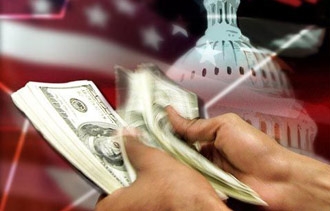They said it wouldn’t happen, but it did: The money companies stashed overseas to protect them from high U.S. corporate tax rates is flooding back in, boosting growth, jobs and confidence in the economy. Thank the Trump tax cuts.
All told, the Bureau of Economic Analysis (BEA) reported, some $305.6 billion returned to the U.S. from overseas accounts. That’s a $1.2 trillion annual rate, and far more than the $35 billion one year before.
The BEA’s analysts explain why this happened: “The large magnitudes (of inward capital flows) … reflect the repatriation of accumulated earnings by foreign affiliates of U.S. multinational enterprises and their parent companies in the United States in response to the 2017 Tax Cuts and Jobs Act.”
In short, the Trump tax cuts did it.
American companies were commonly estimated to have about $2.6 trillion parked in overseas accounts as of 2017. So in the first three months of 2018 alone, some 12% of that overseas stash came back to the U.S. It’s now available here for companies to invest, pay out in dividends and bonuses, hire new workers, purchase new plants and equipment, or just buy back stock.
It’s a shot in the arm for the U.S. economy.
Of course, you say. It’s entirely logical to suppose that by slashing the top corporate tax rate from 35% to 21% — a 40% reduction — and by giving one-time breaks to those companies that had piles of cash sitting overseas, money would flow back into the U.S. After all, Trump’s 21% tax rate is now lower than the current OECD average corporate tax rate of 25%.
But last year, when the tax cuts were still a topic of conversation, some in the media seemed to have trouble with this idea.
“GOP tax bill and overseas profits: Beware the hype,” ran a headline on the PolitiFact website.
“Why the GOP tax plan to repatriate offshore profits may flop,” said a CBS News topper.
“AP FACT CHECK: Trump and the mirage of overseas profits,” yelled the AP’s not-so-subtle headline.
These and other critiques were of the same ilk, using a 2011 Congressional Research Service study to show why the Trump tax cuts wouldn’t work. That study looked at what happened in 2004, when President Bush and congressional Republicans temporarily cut taxes on repatriated profits to 5.25% from 35%.
At the time, the idea was to return financial capital to the U.S. And it worked. Some 843 companies brought back $312 billion.
But, the AP found the cloud’s dark lining, noting “those companies tended to use the money to buy back shares of their own stock, not to hire or expand operations.” The CRS report itself found that the tax break “did not increase domestic investment or employment.”
These assertions need a little context, however.
First, the 2004 profit-repatriation tax break was a one-time event. The Trump tax cuts, in addition to giving companies a break for repatriating overseas profits, cut corporate taxes overall. So the impact will be longer-lasting — permanent, if the Congress makes it so, as it should.
Also, recall that 2004 was a mere three years after the end of the worst stock-market plunge since the Great Depression. Companies’ shares were recovering, but many were still beaten down. So buying their own shares, which bolsters a company’s financial solvency, looked like a smart move at the time.
And also remember: Interest rates, as measured by the Fed funds rate, were rising sharply back then. From a low of 0.94% at the start of 2004, rates surged to just below 2% at the start of 2005 and over 4% by the start of 2006. That’s a fourfold move in two years. Even so, the U.S. unemployment rate during that period fell from 5.4% in 2004 to 4.9% in 2005 and 4.4% by 2006.
Today, no doubt, these same critics would say the same thing. Despite rising interest rates, job growth is more than healthy and key measures of unemployment are close to 30-year lows. Incomes are rising, even as 6 million high-skilled jobs can’t be filled. Jobless claims are at all-time lows. It’s the healthiest job market in decades.
Yet the befuddled media keep calling these bullish economic data “unexpected.”
Well, these weren’t “unexpected” by those who said that tax cuts would work like a charm to boost growth. In the second quarter of this year, GDP growth is almost certain to exceed 3%, again. The Blue Chip consensus of economists expect 3.5% growth, while the Atlanta Fed’s “GDPNow” estimate is at 4.7% currently.
This happened only because President Trump slashed taxes, cut regulations and in general pursued powerful supply-side stimulus that lifted the economy’s ability to produce goods and services.
For the record, GDP growth never topped 3% in any year of Obama’s administration. We were told repeatedly by left-leaning economists and pundits that the days of 3% growth were over. We would have to trim our sails and rein in our expectations for the future.
Donald Trump wasn’t listening. He still isn’t. The Washington Examiner’s Paul Bedard reports Trump recently talked about 5% growth, saying, “You ain’t seen nothing yet.”
Sure, bad things can happen between now and the end of the year. There are shaky economies overseas, including both China and Europe, made all the more sensitive by President Trump’s talk of trade tariffs.
After two years of spectacular gains, stock market investors might head to the sidelines for a while. And if the Fed panics and starts raising rates in an anti-inflation frenzy, something it has done repeatedly in the past, it might once again bring down the economy.
Even so, thanks to the tax cuts, literally hundreds of companies have handed out bonuses, raised base pay, and created new benefits for workers. The money that is flowing back into the U.S. is part of that success, creating jobs and income for American workers. Those who say otherwise are, once again, wrong.
